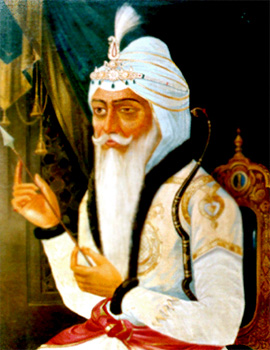 Administration of Ranjit Singh has a close resemblance with the Mughal system of administration. In all essential matters there was no departure. The Maharaja did not avail of European Intelligence and experience in civil administration. This was in contrast with military organisation. A very limited number of Europeans were employed in civil administration. In 1805 the Maharaja was advised by Holkar to organise treasury but he did not do so till 1808 on account of his military occupation. In 1808 Dewan Bhawani Dass was appointed Finance Minister and he divided the financial transactions among a number of Daftars. In the kingdom of Ranjit Singh no distinction was made between articles of luxury and those which formed the necessities of life. Charges were generally made in cash.
Administration of Ranjit Singh has a close resemblance with the Mughal system of administration. In all essential matters there was no departure. The Maharaja did not avail of European Intelligence and experience in civil administration. This was in contrast with military organisation. A very limited number of Europeans were employed in civil administration. In 1805 the Maharaja was advised by Holkar to organise treasury but he did not do so till 1808 on account of his military occupation. In 1808 Dewan Bhawani Dass was appointed Finance Minister and he divided the financial transactions among a number of Daftars. In the kingdom of Ranjit Singh no distinction was made between articles of luxury and those which formed the necessities of life. Charges were generally made in cash.
As regards the land revenue system, the system of Batai was introduced in the beginning of the reign of Ranjit Singh and it continued up to a period of 1823. In 1824, Batai system was replaced by a system of assessment known as Kankut. The share of the Government was determined on the basis of a standing crop whose value was estimated in terms of money. The share of the state was collected in cash. After 1834, Ranjit Singh began to encourage the practice of farming of periods varying from 3 to 6 years. The state demand varied from two-fifths to one-third of the produce of the year. In addition to the regular share of the produce the state claimed a number of Abwabs or cesses which were collected along with the land revenue of which they formed a fixed proportion. The land revenue was collected twice a year, a month or so after the reaping of the two harvests called Rabi and Kharif. The chief officer in charge of collection in a district was the Kardar and he was assisted by subordinate officials like Muqadams, Patwaris and Kanungos. The proceeds of revenue were kept in the district treasury under the contral of a Kardar and were either sent to Lhore or disposed of according to the orders of the Central Government.
Daftar-i-Abwab-il-Tahwil was conquered with the records of accounts of income and expenditure sent by officials. The cashiers were called Tahwildars. Daftar-i-Taujhihat was concerned with the accounts of the royal household. Daftar-i-Mawajib was concerned with the accounts of pay and other emoluments in various government services such as army, the civil staff and clerical establishments. Daftar-i-Roznamcha-i-Ikharazat was concerned with the accounts of daily expenditure under various heads.



















